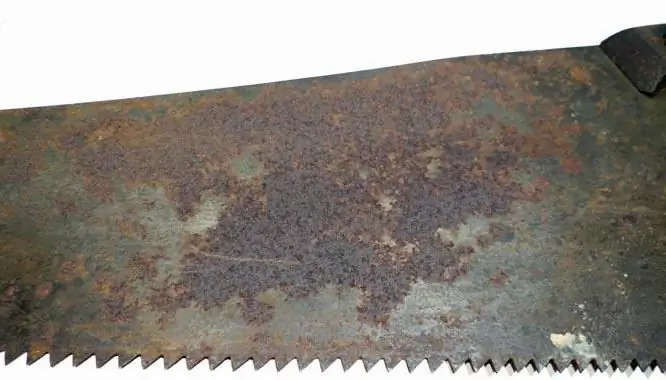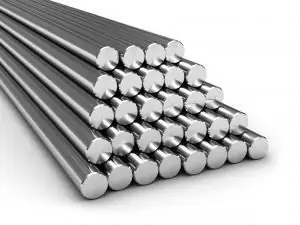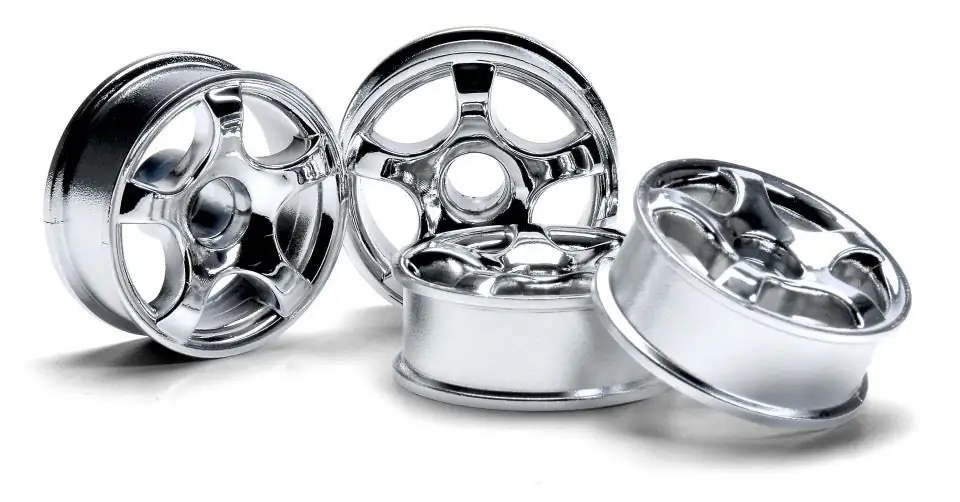2026 Author: Howard Calhoun | [email protected]. Last modified: 2025-01-24 13:10:30
Although aluminum is a non-ferrous metal and, compared to ordinary steel, is relatively expensive, it is widely used by man. This durable and lightweight material can be used in everyday life, in construction, and in production. The chemical formula of aluminum in the periodic table looks like this: Al.
Is it corroded
Rusts aluminum, as you know, very slowly. At least, iron and steel cannot be compared with it in this regard. The resistance of aluminum to corrosion is explained primarily by the fact that, under normal conditions, a thin oxide protective film forms on its surface. As a result, the chemical activity of aluminum is sharply reduced.

Factors affecting rust resistance
Aluminum is resistant to corrosion, but in some cases it can still begin to break down quite quickly due to oxidation. This usually happens when the film is damaged for some reason or it is impossible to form it.
Most often, aluminum loses its external thin protection under the influence of acidsor alkalis. Ordinary mechanical damage can also cause the destruction of the film.
Types of corrosion
After the destruction of the film, Al and its alloys begin to rust, that is, self-destruct, like many other metals. This can expose aluminum and corrosion:
- Chemical. In this case, rusting occurs in a gaseous environment without water. In this case, the surface of the aluminum product is destroyed evenly over the entire area.
- Electrochemical. Corrosion of aluminum in this case occurs in a humid environment.
- Gas. This type of corrosion occurs when aluminum is in direct contact with some chemically aggressive gas.

The equation for aluminum corrosion (oxygen oxidation) in air is as follows: 4AI+3O2=2AL2O 3.
The chemical formula of the oxide protective film is AL2O3.
Alloys
The most corrosion-resistant variety is technical aluminum. That is, almost pure 90% metal. Aluminum alloys, unfortunately, are much more prone to rust. It is believed that magnesium impurities reduce the corrosion resistance of this metal least of all, and copper impurities most of all.
Mg-Al alloys
Such materials are widely used in construction, food and chemical industries. They are also very often used in mechanical engineering. It is believed that such materials are well suited for the construction of structures,exposed to sea water.
In the event that magnesium is not more than 3% in the composition of the alloy, it will have almost the same anti-corrosion properties as technical aluminum. Magnesium in such an alloy is in solid solution and in the form of Al8Mg5 particles uniformly distributed throughout the matrix.

If the alloy contains more than 3% of this metal, Al8Mg5 particles begin to fall out, for the most part, not inside the grains, but along their boundaries. And this, in turn, has an extremely negative effect on the anti-corrosion properties of the material. That is, the product becomes much less resistant to rust.
Magnesium and silicon alloys
Such materials are most often used in engineering and construction. Mg2Si make alloys of this variety very strong. Sometimes copper is also a component of such elements. It is also introduced into the alloy for hardening. However, copper is added to such materials in very small quantities. Otherwise, the anti-corrosion properties of the aluminum alloy may be greatly reduced. Intercrystalline rusting in them begins already with the addition of more than 0.5% copper.
Also, the susceptibility to corrosion of such materials may increase with an unjustified increase in the amount of silicon included in their composition. This substance is added to aluminum alloys, usually in such proportions that after the formation of Mg2Si nothing remains. Silicon in its pure form contains only some materials of this variety.

Corrosion of aluminum andits zinc alloys
Al rusts, as already mentioned, slower than its alloys. This also applies to materials of the Al-Zn group. Such alloys are in great demand, for example, in the aircraft industry. Some varieties may contain copper, others may not. In this case, the first type of alloys, of course, is more resistant to corrosion. In this regard, Al-Zn materials are comparable to magnesium-aluminum.
Alloys of this variety with the addition of copper show signs of some instability to rust. But at the same time, they are destroyed due to corrosion, they are still slower than those made using magnesium and Cu.

Basic ways to deal with rust
Of course, the rate of corrosion of aluminum and its alloys can also be reduced artificially. There are only a few ways to protect such materials from rusting.
For example, it is possible to exclude the contact of this metal and its alloys with the environment by painting paintwork materials. Also, an electrochemical method is often used to protect aluminum from rusting. In this case, the material is additionally covered with a layer of more active metal.
Another way to protect Al from rusting is high-voltage oxidation. A powder coating technique can also be used to prevent corrosion of aluminum. Used to protect it, of course, and rust inhibitors.
How oxidation is done
Using this technique, aluminum and its alloys are often protected from corrosion. Performoxidation under a voltage of 250 V. Using this technique, a strong oxide film is formed on the surface of a metal or its alloy.
Influence on the material by current in this case is carried out using water cooling. At low temperatures, due to stress, the film on the surface of aluminum is formed very strong and dense. If the procedure is performed at high temperatures, it turns out to be quite loose. Aluminum processed in such an environment needs additional protection from contact with air (painting).

When using this technology, the product is first degreased in a solution of oxalic acid. The aluminum or alloy is then dipped into alkali. Next, the metal is affected by current. At the final stage, if the oxidation was carried out at a sufficiently high temperature, the material is additionally dyed by immersion in s alt solutions, and then treated with steam.
Using LMB
This method, like oxidation, is used to protect aluminum from rusting quite often. Such material can be painted by dry, wet or powder method. In the first case, aluminum is first treated with a composition containing zinc and strontium. Further, the LKM itself is applied to the metal.
When using the powder method, the work surface is pre-degreased by immersion in alkaline or acid solutions. Further, chromate, zirconium, phosphate or titanium compounds are applied to the product.
Useinsulators
Very often, other metals become stimulants for the onset of corrosion processes in aluminum and its alloys. This usually happens with direct contact of products or their parts. In order to prevent aluminum from rusting, special insulators are used in this case. Such gaskets can be made from rubber, paronite, bitumen. Also in this case, varnishes and paints can be used. Another way to protect aluminum from corrosion in contact with other materials is to coat its surface with cadmium.

It is especially important to ensure the insulation of aluminum parts in various mechanisms and assemblies from direct contact with copper. It is also believed that not only parts made of Al should be protected from contact with other metals. In terms of corrosion resistance, iron is much inferior to aluminum, like steel, for example. Therefore, such metals and some others are often protected in a special way. The materials are simply covered with a protective aluminum layer. Of course, such products should also be protected from contact with copper or other metals.
Recommended:
Pitting corrosion: causes. Methods for protecting metals from corrosion

During the operation of metal products, they are exposed to various types of destructive effects, among which pitting corrosion stands out as the most dangerous and unpredictable
Heat-resistant alloys. Special steels and alloys. Production and use of heat-resistant alloys

Modern industry cannot be imagined without such material as steel. We encounter it at almost every turn. By introducing various chemical elements into its composition, it is possible to significantly improve the mechanical and operational properties
Corrosion of copper and its alloys: causes and solutions

Copper and copper alloys have high electrical and thermal conductivity, can be machined, have good corrosion resistance, so they are actively used in many industries. But when it enters a certain environment, corrosion of copper and its alloys still manifests itself. What is it and how to protect products from damage, we will consider in this article
What is tinning? Methods for protecting metal from corrosion

Tinning is widely used in industries such as aviation, radio engineering and electrical engineering. Products used for cooking and storing food are also subjected to this process. What is tinning, what is it used for and how this operation is carried out correctly, and we will consider in this article
Welding of copper and its alloys: methods, technologies and equipment

Copper and its alloys are used in various sectors of the economy. This metal is in demand due to its physicochemical properties, which also complicate the processing of its structure. In particular, the welding of copper requires the creation of special conditions, although the process is based on fairly common thermal treatment technologies

